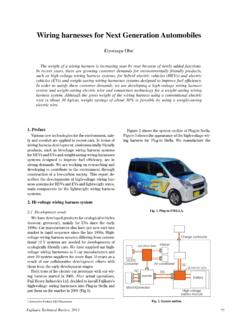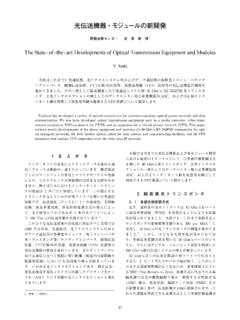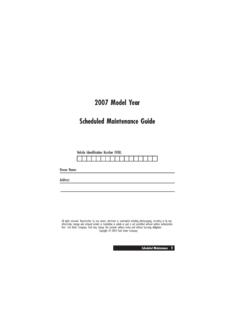Transcription of B-Surface SBR of Load Detection Type - Fujikura
1 56C52_ B-Surface SBR of load Detection TypeTetsuya Kawahira,1 Shigeru Nakazaki,1 Naohiro Kikukawa,2 Noriyuki Karasawa,3 Julian Kuetgens,3 Tobias Schuetteler,3 Adrian Tomesc,4 Yi Yang,5 and Yuta Morioka6 Many vehicles are now equipped with a Seat Belt Reminder (SBR) system. The system detects occupants in the front seat and reminds unbuckled occupants to fasten their seat belt by giving a warning light or an audible sound. We manufacture SBR sensors with membrane switches placed between the trim cover and the cushion pad of a passenger seat. Recently, customers have required us to develop a new type of SBR sensor, which is mounted on the bottom surface of a cushion pad, for the standardization of sensor shapes.
2 Consequently, we have developed a new SBR sensor of load Detection type using a metal IntroductionAutomobile safty is assessed according to laws and regulations and New Car Assessment Program (NCAP) of each region of the world. NCAP gives points to vehicles equipped with an SBR system in the passenger seat in EU, China, South America, ASEAN, Australia, Korea and Japan. In EU, SBR sensors have been used in over 90% of passenger cars. In China, foreign-affiliated automotive makers employ SBR sys-tems as standard parts, and local makers have already started to use them. Existing SBR sensors consist of multi-switches on a membrane and are mounted on a seat cushion (A-Surface).
3 It is difficult to standardize SBR sensor designs because the designs of the seat cushions are different from each other. Recently, Eu-ropean customers have requested us to develop a new SBR sensor that is put under the seat cushion (B-Sur-face), aiming at the standardization of the design (Fig. 1). In general, seat cushions are mounted on a pan fab-ricated from sheet metal or a corrugated S-spring. We have already launched sales of B-Surface SBR systems that have been mounted on the seat pan and fixed into the groove of the seat cushion. This report describes the history of our SBR systems and the development of the new SBR of load Detection type, which uses met-al film, needs no grooves on the cushion and is com-bined with the S-spring.
4 2. Our efforts to develop SBR History of SBR sensor development We started to provide membrane switches for SBR sensors to a Tier 1 maker in 2005, we launched the production of SBR sensors with a harness. Currently, we provide them to custom-ers in Japan, China and : Mass-production of membrane switches for SBR sensors2003: World s-first development of dual-cell SBR systems 2004: Development of flame-retardant ink for auto-motive use with ink : Mass-production of dual-cell SBR : Mass-production of B-Surface SBR systems (membrane-type)2012: Establishment of Fujikura Automotive Europe GmbH (FAE) for R& : Development of B-Surface SBR system of load Detection A-Surface SBR sensorThe membrane switch of the sensor consists of two polyester films between which the circuits have been 1 Automotive Module Engineering Department2 Functional Module R&D3 Fujikura Automotive Europe GmbH4 Fujikura Automotive Romania Fujikura Zhuhai CO.
5 , Intellectual Property Technology DepartmentA Surface SBRB Surface SBRFig. 1. Location of SBR Technical Review, 201657printed. The films sandwich a spacer with holes to en-sure a point of contact. When the upper film on the spacer hole is pressed, the electrode on the film comes in contact with that on the lower film. This contact point works as a switch. The SBR sensor consists of membrane switches, which are arranged at appropri-ate points on the seat cushion based on the stress dis-tribution measurement results to detect a passenger s different sitting positions (Fig. 2). The sensor is con-nected to a harness or connector.
6 We have developed the world s first dual-cell structure with two switches in series so as to reduce Detection errors caused by luggage in 2003. We have also installed endurance test machines to test sensors for the China market in FZL in 2011. B-Surface SBR sensor for seat pan frameFor the A-surface SBR sensor, the cells are placed on the seat surface on which a passenger sits. On the other hand, for the B-Surface SBR sensor, the best cell position needs to be found for each seat because de-signs of seat cushions vary. Consequently, a cell position for the B-Surface sen-sor is determined by measuring the stress distribution on the seat dual cell structure, which is used in the A-surface SBR sensor, is also used in the B-Surface SBR sensor to reduce Detection errors.
7 The B-Surface SBR sensor is difficult to turn on because the pressure applied to the seat bottom is low compared with the A-surface SBR sensor. We, therefore, have adopted a new struc-Fig. 2. Stress distribution on seat logicFig. 3. Dual cell 4. Measurement result of stress distribution on center of seat 5. Simulation result of stress distribution on center of seat ture of the seat bottom with a urethane foam pad placed under the sensor to increase the sensor structure has grooves to ensure that the switches turn off when no load or a small load is ap-plied to the seat. The groove depth and shape were optimized by using CAE technology.
8 2) 3) We also have developed evaluation equipment consisting of a seat, an X-Y table and a load cell in a thermostat chamber. Luggage or a passenger dummy was attached onto the load cell so that it applies a load onto the seat. The test equipment can measure sensor-activation load distri-bution on the seat and displacements of the seat in re-sponse to changes in B-Surface SBR sensor for S-spring Development of specificationsAmong a wide-ranging customer requirements, three main concepts are shown below:1) Minimizing the use of grooves on the seat bottom2) Direct connection of the sensor to harness3) Space savings by reducing the number of contact B-Surface SBR sensor of load Detection typeWe have succeeded in developing a load -detecting B-Surface SBR system structure, which enabled the system to accurately detect even low pressure and maintain the characteristics despite deterioration due to aging, for instance, deformation of the cushion.
9 The features of the structure are an upper case, which has a boss on the center, and a thin metal plate. The boss amplifies pressure received by the upper case and transmits it to the metal film. The material of the metal film was selected by taking maintenance of its shape and sensor sensibility at high load into consideration. In addition, a PCB board was used for direct connec-tion to the molded-in terminals of the lower case in response to customer request. The terminals were of the press-fit type used mainly in Europe. They were press-fitted into through-holes on the PCB board. The upper electrode was made of partially-gold-plated stainless film.
10 The support plate, on which the sensor unit was mounted, used high-strength stainless steel. The case had glass-fiber-based resin to ensure its strength and dimensional accuracy (Fig. 7). The de-sign of the upper case was optimized by CAE analysis to avoid cracking of the case at the time of fitting be-tween the upper and the bottom cases, or the upper case and the connector. The following shows the procedure to set sensor of passenger in 13 sitting positions and luggage in 3 positions were measured by the load Fig. 6. Test equipment for SBR sensor example: Sensor-activation load distribution on seat 7. Structure of B-Surface SBR sensor for S-spring caseMetal filmSpacerPCBL ower caseSupport plateFujikura Technical Review, 201659cell which was put on the S-spring and in contact with the seat bottom (Fig.)














